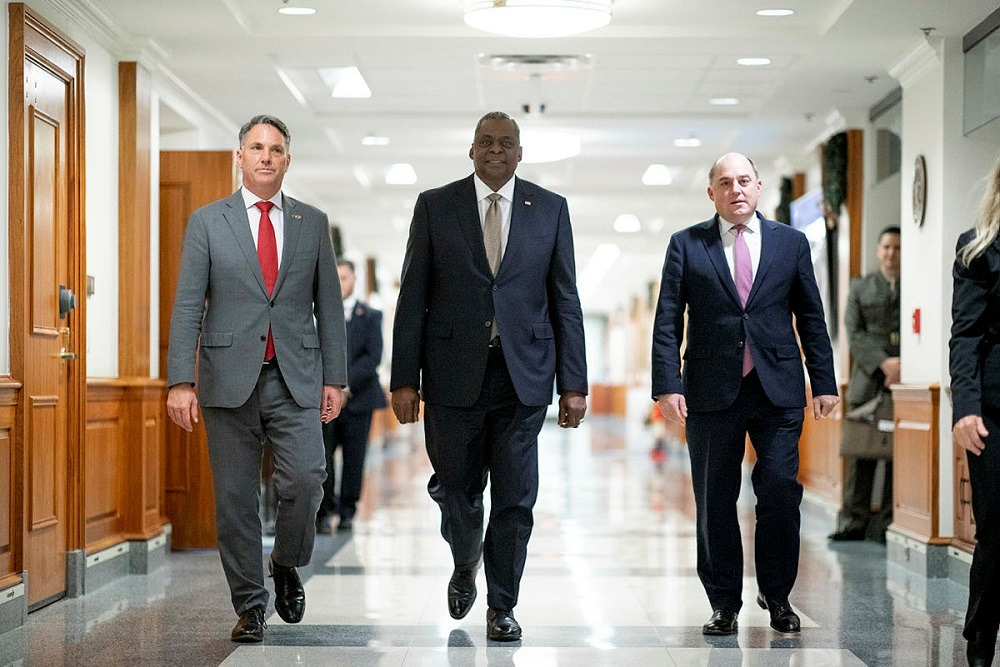Defence has long been seen as a necessary burden on the federal budget. However, it is assuming the status of an urgent priority in the wake of the AUKUS agreement and the far-reaching reform urged by this year’s defence strategic review (DSR). Both are responding to a much more challenging geopolitical environment and the realisation that Australia doesn’t have the luxury of time to achieve readiness.
This year’s defence budget reflects the urgency of the demands on Defence to the extent that it includes the initial spending on the AUKUS nuclear-powered submarines and the first response to the DSR, despite there being only very approximate estimates for how that spending is to be scheduled and for the savings that will pay for them.
However, the urgency of the demands on Defence isn’t reflected in its short-term funding. The only increase in the defence budget over the next three years is compensation for the increased cost of imported military equipment flowing from a fall in the value of the Australian dollar.
Excluding this, the core funding of Defence (not including the Australian Signals Directorate) has actually been reduced at a time when unprecedented demands are being placed on it. Between 2023–24 and 2025–26, Defence funding, excluding compensation for adverse foreign exchange movements, drops from $154.0 billion to $152.5 billion.
Both the AUKUS submarines and the DSR conclusions highlight an approach in which capability will drive budget conversations, not vice versa. That is welcome. But there is clearly much more work to be done to clarify the capability implications of the DSR, and then reflect those accurately—and at the appropriate time—in the budget.
The difficulty in bringing the DSR reforms and the spending on submarines into the budget is understandable. The timing of the DSR meant that it reached the staff compiling Defence’s budget very late in the annual process, while the nuclear-powered submarine program is of historically unprecedented complexity for any government project. The broad outline of the submarine program was only announced in March 2023.
New programs responding to the DSR, such as a long-range strike capability or the hardening of the northern Australian bases, are not the subject of budget measures. Defence is expected to provide the additional funds needed with savings obtained from other programs.
Funding in each year continues to move faster than the predicted annual rate of inflation, consistent with the recommendations of the 2016 defence white paper and the 2020 defence strategic update. However, Defence’s financial controllers have fewer real resources to work with over the next three years than they were expecting in March 2022, when the budget still contained the French submarine program and the DSR hadn’t even been commissioned.
The surge in inflation over the past year has made the constraints of a reduced funding base even tighter. Treasury now expects inflation to reach 6% this year, or double the level it predicted a year ago. Inflation is being powered, both in Australia and globally, in large part by an overheated economy that’s the result of record-low interest rates and large government deficits and further exacerbated by the impact of the Russian invasion of Ukraine on food and energy markets.
With unemployment at near record lows, Defence has been unable to meet its recruitment targets, which has been further exacerbated by increasing separation rates among uniformed personnel. Defence had planned for the Australian Defence Force to raise its numbers by 2,201 in 2022–23, but instead faced a contraction in size by 1,389 uniformed personnel.
The rigid constraints on defence funding over the next four years reflect Treasury’s judgement that total government spending must be curbed if inflation is to be brought under control. Treasury’s economic forecasts assume that the combined efforts of government and the Reserve Bank of Australia will succeed in taming inflation over the next 18 months, bringing inflation back into the Reserve Bank’s target band by 2024–25.
The government will start providing increased funding for defence from 2027–28 onwards. An amount of $30.5 billion has been set aside for defence spending out to 2032–33. It’s expected that this will increase the defence share of GDP from around 2.05% to more than 2.3%. The additional funding will lift Defence’s share of government spending from about 8.2% now, including both operational and capital spending, to about 9.7% by 2032–33.
However, the principal task for Defence over the year ahead is to decide how to reconfigure its capability acquisition programs and the ADF’s force structure in line with the DSR and the difficult budget constraints. That work is to be completed ahead of the planned 2024 national defence strategy, which is expected to be released before next year’s budget.
The uncertainty surrounding Defence’s integrated investment program will affect defence industry as the scope and schedules of major programs are reviewed. Although Defence has raised the share of its procurement sourced domestically from about 45% to 55% over the past five years, it’s possible that the pressure to acquire new capabilities quickly will result in more off-the-shelf imports.
Given the intense reordering of Defence’s capital program expected over the year ahead, this year’s ASPI defence budget brief isn’t a detailed examination of the major acquisition programs. Rather, it’s a guide for the government, industry, academia and citizens interested in Australian defence strategy, capability and budget.
The strategic context for the 2023–24 defence budget is complex and extremely challenging. There’s currently a gap, and quite a significant one, between the rhetoric of the 2023 DSR and the 2023–24 defence budget (and forward estimates). How Defence and the rest of government will work together to bridge the gap will become clearer over the coming year. This year’s budget brief focuses on what ASPI can usefully contribute to that process, and where the key issues lie in the defence budget.
Source : TheStrategist

